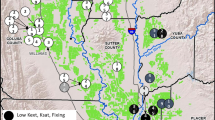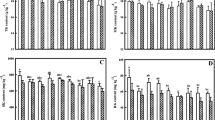Abstract
Not much is known about the response of lowland rice to K fertilization under Brazilian conditions. A field experiment was conducted during four consecutive years to determine the response of three lowland rice (Oryza sativa L.) cultivars to K fertilization on a Low Humic Gley soil. In the first two years, K was broadcast at rates of 0, 42, 84, 126, and 168 kg K ha−1. In the last two years K rates were reduced to 0, 25, 50, 75, and 100 kg K ha−1 and applied in a band. Potassium significantly (P < 0.01) increased grain yields but the response varied from cultivar to cultivar and year to year. Yield responses to K fertilization were superimposed on a general trend of increasing grain yields across the four growing seasons. Mean grain yields increased 14.3% with broadcast application of K in the first two years and 10.4% with banded application of K in the last two years when compared to the control treatments. Extractable soil K increased with K application rate and decreased with soil depth. Potassium was rapidly removed from the soil and yearly broadcast or banded application of K can be expected to result in a significant increase in grain yield of lowland rice in these soils.
Similar content being viewed by others
References
Braga JM and Defelipo BV (1974) Spectrophotometric determination of phosphorus in extracts of soil and plant material. Revista Ceres 21: 73–85
Chen JZ, Du CL and Na MT (1982) Effect of potassium nutrition of rice on soil oxidation-reduction conditions. Soils 14: 140–142
De Datta SK (1981) Principles and Practices of Rice Production. New York: John Wiley and Sons
De Datta SK and Mikkelsen DS (1985) Potassium nutrition of rice. In Munson RD (ed.). Potassium in Agriculture, pp 665–699. Madison, WI: American Society of Agronomy
Fageria NK (1984) Fertility and mineral nutrition of rice culture. Rio de Janeiro: EMBRAPA-CNPAF/Editora Campus
Heald WR (1965) Calcium and magnesium. In Black CA (ed.) Methods of Soil Analysis Part 2, pp 999–1010. Madison, WI: American Society of Agronomy
Institute of Soils and Fertilizers (1974) Effect of potassium fertilizer. T'u Jang Fei Liao Tung Hsin 1: 21–32
Lu RK (1981) The fertility and fertilizer use of the important paddy soils of China. In Proceedings of symposium on paddy soil, pp 160–170. Berlin: Springer-Verlag
Tanaka A and Yoshida S (1970) Nutritional disorders of the rice plant in Asia. IRRI Tech. Bull 10 Los Banos, Philippines: International Rice Research Institute
Vettori L (1969) Methods of Soil Analysis. Tech Bull 7 Rio de Janiero: EPFS
Author information
Authors and Affiliations
Rights and permissions
About this article
Cite this article
Fageria, N.K., Baligar, V.C., Wright, R.J. et al. Lowland rice response to potassium fertilization and its effect on N and P uptake. Fertilizer Research 21, 157–162 (1990). https://doi.org/10.1007/BF01087425
Received:
Accepted:
Issue Date:
DOI: https://doi.org/10.1007/BF01087425




